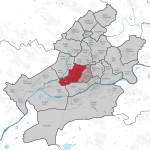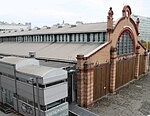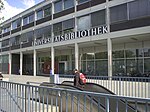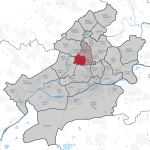Frauenfriedenskirche

The Frauenfriedenskirche (German for Our Lady's Peace Church) is a Roman Catholic church in Bockenheim (Frankfurt am Main) (Germany). It was built by Hans Herkommer from 1927 to 1929, on a rise then known as Ginnheimer Höhe. The church is an unusual example of interwar modernist church architecture, combining elements of expressionism with the "New Objectivity" of Bauhaus architecture, and using monumental mosaics for external and internal decoration. The plan to build such a church was developed in 1916 by Hedwig Dransfeld, then chairperson of the Katholischer Deutscher Frauenbund (Catholic German Women's Organisation). The church was meant to represent a prayer for peace in stone and also serve as a memorial for the fallen of the First World War. The foundation money initially collected for the project was lost due to the 1914–1923 German hyperinflation. The church was finally completed on 5 May 1929 and handed to the Catholic congregation of Bockenheim. It was badly damaged in the Second World War, and afterwards rebuilt with money donated for the purpose. The names of any German soldiers killed or missing in either World War were displayed in the church in return for a donation.
Excerpt from the Wikipedia article Frauenfriedenskirche (License: CC BY-SA 3.0, Authors, Images).Frauenfriedenskirche
Zeppelinallee, Frankfurt Bockenheim (Innenstadt 2)
Geographical coordinates (GPS) Address External links Nearby Places Show on map
Geographical coordinates (GPS)
| Latitude | Longitude |
|---|---|
| N 50.128333333333 ° | E 8.6455555555556 ° |
Address
Frauenfriedenskirche
Zeppelinallee 101
60487 Frankfurt, Bockenheim (Innenstadt 2)
Hesse, Germany
Open on Google Maps









